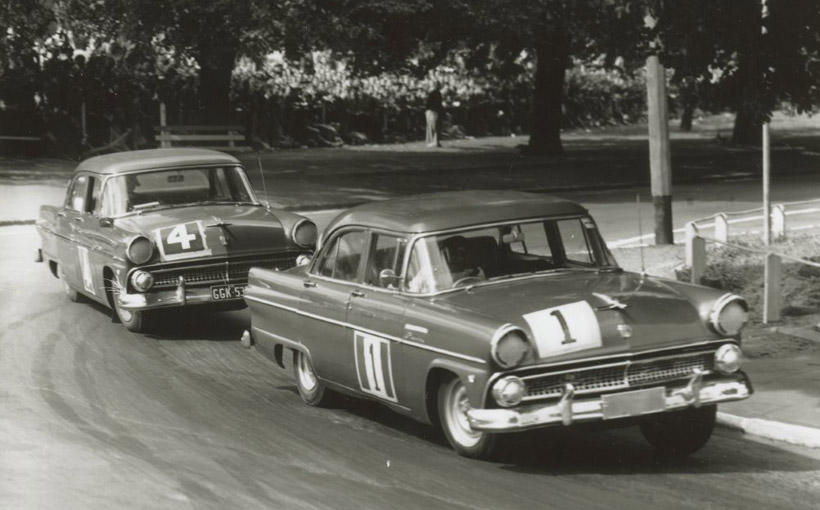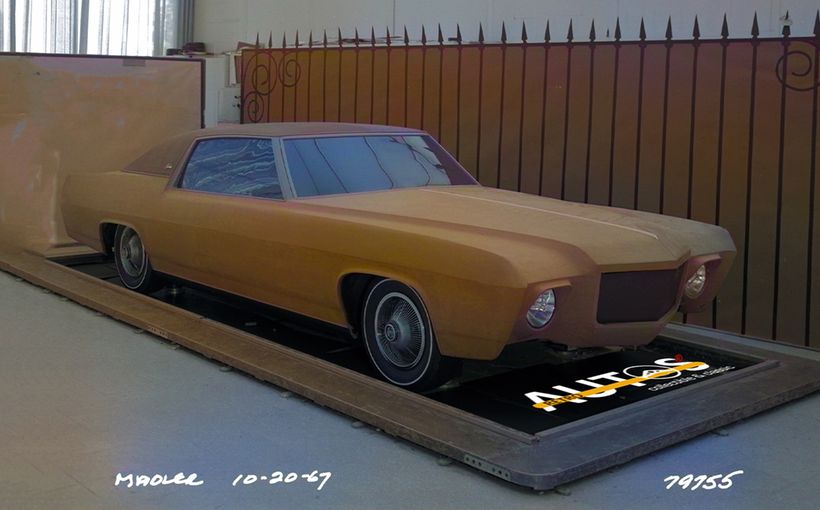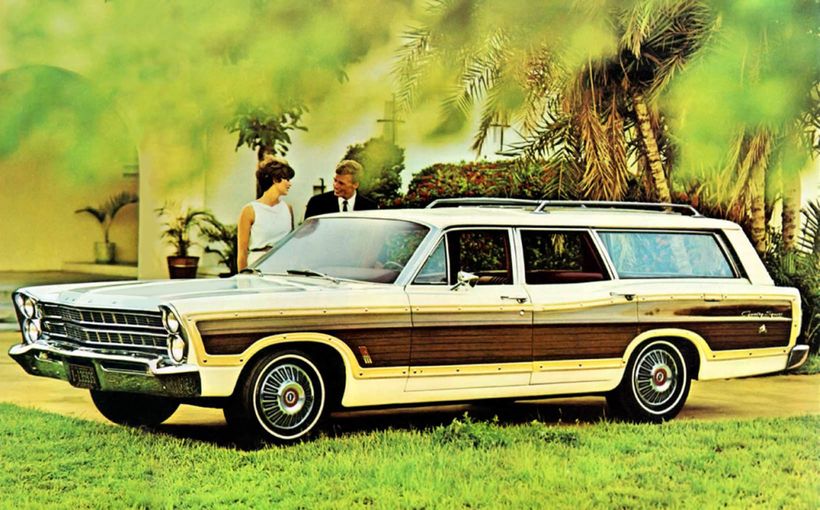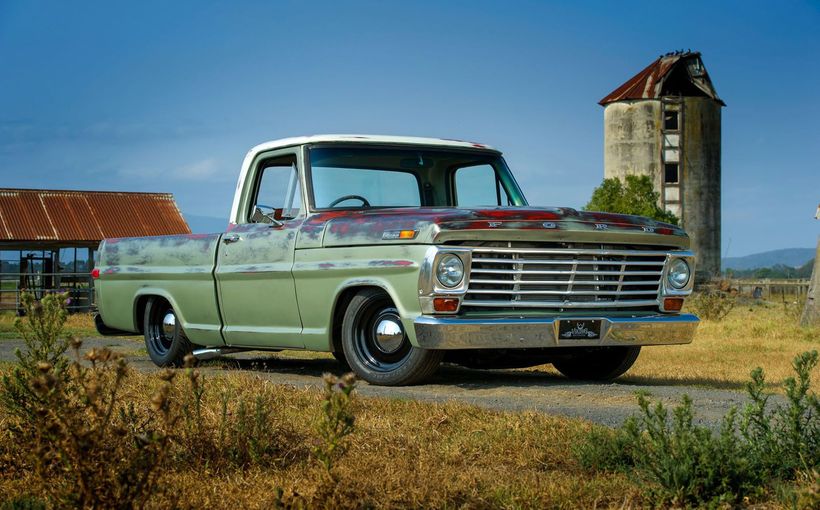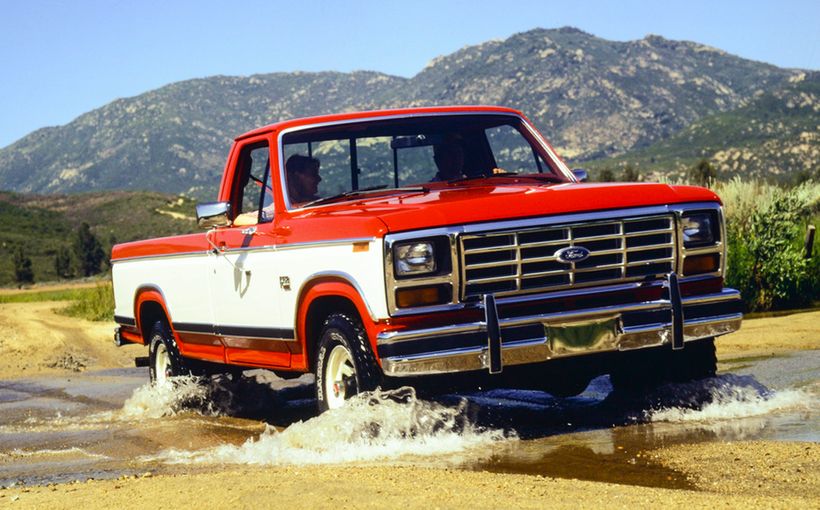Ford Customline 1955-59: In its prime before prime-time

The legendary Len Lukey (No.1) and ‘young gun’ Norm Beechey (No.4) are captured in their historic battle in ’55 Customlines at Albert Park in 1956. Note the straw poking out of Beechey’s front bumper, after he ran wide and collected some hay bales. (Image from: Chevron Publishing)
Ford’s mighty Customline V8 sedan could well have won multiple Australian Touring Car Championships had Australia’s premier tin-top title been up and running a few years prior to its inception in 1960.
Henry’s handsome, rugged and fast family sedan - particularly the 1955-59 models powered by the 272 cid (4.5 litre) overhead valve Y-block V8 - was at its competitive peak long before the ATCC existed. In fact, prior to 1960, there wasn’t even a national set of touring car rules.
Touring car races were mostly support events at open wheeler and sports car meetings and media coverage was poor. It was generally regarded as a bit of fun in which open wheeler drivers would often compete in the road cars they used to tow their racing cars.
The tin-top races were also staged by a multitude of promoters in different states, who all had their own sets of rules. As a result there was virtually no limit to the modifications being performed. The cars became increasingly fast – and dangerous.
However, it was this run-what-ya-brung philosophy and close relationship with the showroom product that ensured touring car racing’s rapid and irreversible rise in popularity in the 1950s and ‘60s to become Australia’s number one motor sport attraction.
The introduction of the ATCC in 1960 brought with it a new national set of rules (Appendix J), by which time the mighty DOHC 3.4 litre Mark I Jaguars were the cars to beat and the Customline had vanished from the showrooms.
So the Customline never had a chance to wear a prestigious ATCC or Bathurst 500 crown. Even so, the car affectionately known as the ‘Cusso’ played a pivotal role in touring car racing’s rise to prominence in Australia.

Len Lukey set numerous hillclimb records in his Customline. Here he’s tackling Victoria’s famous Rob Roy course in 1958, after his original ’55 had been updated to ’56 trim. And didn’t that cause some confusion!
Len Lukey
The crowning motor sport achievement for the man behind the hugely successful Lukey Mufflers exhaust brand was his win in the CAMS Gold Star (Australian Drivers’ Championship) in 1959 driving a Cooper Climax open wheeler.
However, in his beloved Customlines, Lukey was also one of the most successful touring car drivers to compete in the pre-ATCC era, helping to raise the profile of tin-tops in the 1950s to the point where a national championship was justified.
He was destined to make the transition to a Customline after he started competing in a 1953 Anniversary Mainline ute that doubled as his workhorse during the week. The Victorian’s early outings were in hillclimb events held at the popular Templestowe and Rob Roy courses near Melbourne.
He soon progressed to circuit racing, but when utes were banned in 1954 because they were deemed inappropriate (funny how V8 Utes are so warmly accepted as race cars today!) Lukey switched to the latest 1955 Customline powered by the new Y-block V8 which with some skilled preparation by Harry Firth really put him on the racing map.
Firth, who would later work for Ford on numerous competition programs in the 1960s before setting up the Holden Dealer Team, was quickly making a name for himself as a driver and specialist tuner of competition cars. His input in Lukey’s ’55 Customline was signature Harry.
He typically paid attention to all the little details that added up to a lot, like making sure all the internal engine clearances were correct and oil surge was contained, raising the compression ratio, tidying up the cylinder head porting and creating a custom-made high performance valve train.
He also adapted a pair of large two-barrel carburettors from a Ford truck to greatly increase the Y block’s air/fuel diet and worked with Lukey to design some free-flowing exhaust extractors which proved very popular in the aftermarket.

Another wonderful view of Lukey at Rob Roy in 1958. When he sold this car later that year, it held class records at Hepburn Springs and Templestowe and the outright tin-top record at Rob Roy.
Firth claimed around 250 bhp for his hand-fettled mill – a very healthy set of numbers for the time – with a top speed exceeding 120 mph (190 km/h). Ford’s new Y block was not a big revver, running out of puff before 6000 rpm, so Lukey paid a lot of attention to diff ratios and wheel diameters to maximise the Customline’s ample torque.
The woefully inadequate cast iron drum brakes of the era would overheat and suffer severe fade after only a few hard applications in racing, so Firth replaced them with special drums he designed and cast locally with integral fins to aid cooling. He also fitted special Ferodo high temperature brake linings and the Customline’s suspension was uprated with heavy duty springs and Armstrong shocks.
Lukey’s Firth-tweaked Cusso was quick straight out of the box and started breaking records from the day it debuted at Templestowe in the winter of 1955. At Orange (NSW) in January 1956, it also set the fastest time for a sedan over the quarter mile, with a claimed top speed of 106.6 mph (170 km/h plus).
Lukey’s star was clearly on the rise so he soon graduated to a Cooper Bristol front-engined open wheeler for circuit racing. Even so, he continued to campaign the Customline in support events for touring cars, enjoying great success until he rolled the car at Philip Island’s Southern Loop during his first meeting there in January 1957.
The car required extensive body repairs so Lukey removed its hot race motor, brakes and suspension and installed them all in a new 1956 model. This Olympia Blue example not only became the new tow car for the Cooper, but also took over where the ’55 had left off by competing in hillclimbs and the touring car support races at meetings where Len was racing the open wheeler.
The rebuilt ’55 returned to the track later in the year, but Lukey had chosen to visually update it with ’56 model bright-work and a new two-tone blue paint scheme. As you can imagine the return of this car in its new guise caused great confusion until the ‘stand-in’ Olympia Blue ‘56 was retired from race duties.

Lukey’s home-grown attempt to minimise aerodynamic drag on his famous Cusso did the trick at Coonabarabran in 1957 when he set a new Australian land speed record for sedans. This heavily taped road rocket topped 200 km/h. In 1950s terms, that was warp speed. Image: Chevron Publishing
Lukey continued to enjoy great success in the face-lifted ’55 (Vic reg GJL-432), competing in hillclimbs, track sprints and races in Victoria and other states. By then his Cusso was widely regarded as the fastest sedan in the country, as proven by his setting of a new Australian land speed record on a closed section of public road near rural Coonabarabran (NSW) in September 1957.
In preparation for his record-breaking run, Lukey paid a lot of attention to the car’s aerodynamics which really was cutting edge stuff in 1950s motor sport.
He directed air flow away from the drag-inducing open grille with a pair of wind deflectors and installed a flat belly pan underneath to smooth airflow under the car. He also made up some neat air-piercing cones for the headlights and taped up all the body gaps and chrome work to minimise drag. The only way to get in and out of the car after that was through the driver’s door window.
The official speeds recorded were based on the average of two timed passes in opposite directions. According to the sketchy reports of the day, Lukey set a cracking two-way average speed of 123.3 mph, with a strong tail wind helping him to a claimed top speed on one pass of 130 mph (208 km/h). Keep in mind, this was also his tow car!
Lukey continued to race Australia’s fastest Customline until it was sold in 1958 with a stack of records to its name. After he won his 1959 Gold Star title in the Cooper Climax, Len promptly retired from race driving to concentrate on his booming exhaust business.
However, he remained actively involved in the sport as an entrant (with the mighty ‘Big Red’ 406 cid Galaxie for Lex Davison and Norm Beechey) and purchased the Philip Island circuit in the mid-1960s. Len Lukey succumbed to cancer in the late 1970s but his racing legacy – particularly in Ford Customlines – will never die.

How we’ll always remember Lukey and his famous Customline, making another record-breaking run at Rob Roy. Lukey’s contribution to the popularity of touring car racing in Australia was immeasurable.
Norm Beechey
One of Australia’s greatest racing characters, the irrepressible Stormin’ Norm Beechey, cut his racing teeth behind the wheel of a Ford Customline. According to Beechey, the arrival of the Y-block V8 in 1955 turned it into a ‘rocket-ship’ that was light years ahead of anything else available at the time.
Beechey was a cherub-faced 22-year-old kid from Brunswick, big on bravado but short on dollars and racing experience when he appeared at his first major race meeting at Melbourne’s Albert Park in 1956. It was a date with destiny that would thrust him into the national spotlight.
It was a special meeting timed to coincide with the city’s hosting of the Olympic Games that year. Beechey was lucky to get a start after entries had closed, thanks to the generosity of fellow competitor Basil Rice who was planning to run a side-valve V8 Ford twin-spinner in the touring car event.
When Norm took Basil for a ‘spirited’ drive in his new overhead valve V8 Customline, Rice realised his old twin-spinner would not stand a chance of winning against the latest Ford weaponry so he generously offered his entry to Beechey.
This caused great confusion at the meeting, though, because the entry list and race reports all referred to the driver of the very rapid No.4 Customline as Basil Rice, even though it was Beechey at the wheel!

A star is born. Norm Beechey was just 22 when he burst onto the local touring car scene at Albert Park in 1956 aboard his ’55 Customline. Just look at how hard ‘Stormin’ Norm’ was working the big V8 Ford on its pizza-cutter tyres and standard suspension. (Image from: Chevron Publishing)
Not that Norm was even considered to be in the same class as established ace Len Lukey and his highly developed ’55 Customline prior to that historic clash.
Beechey, the son of a car dealer, was a fast learner with a sharp business brain. By the time he was 13 he was already dealing in used cars. This usually involved buying cars cheap in regional areas, driving them back to Melbourne for a quick detail and selling them for healthy mark-ups.
So by the time he was in his late teens, young Norm had developed some impressive car control after years of high speed driving on remote dirt roads.
When he faced the starter at Albert Park, Beechey also had plenty of street racing experience thanks to another boy from the back streets of Brunswick, who would also achieve great fame as a racing driver and great fortune as a tyre retailer. His name was Bob Jane.
The two young tearaways were not only good mates but also mad as cut snakes, racing each other at every opportunity on the streets of Melbourne and scaring the life out of any pretty young things who dared to ride with them.
It was perhaps that naive mix of self-taught car control and bravado that allowed Beechey to race wheel to wheel with an established star like Len Lukey at Albert Park.
Beechey was running standard 15-inch wheels and Olympic tubeless tyres, without any special brake linings or finned drums etc. He even kept the stock camshaft but he and a mate fabricated their own inlet manifold with dual carburettors and a dual exhaust system that worked remarkably well.
Norm readily admits his racing technique was pretty poor back then. He hadn’t yet mastered the use of braking markers. As a result, he’d stomp on the middle pedal way too late and have to throw the car sideways into the corners to scrub off excess speed, much to the delight of spectators.
He would then exit with an armful of tyre-smoking, power-sliding opposite lock in one hand, with his other braced against the roof to hold himself upright on the slippery bench seat.

A fabulous shot of Lukey cranking on some opposite lock at Albert Park in 1956 as he works hard to keep the young Beechey at bay. Note the complete absence of safety barriers on the original Albert Park course – a far cry from today’s GP track. (Image from: Chevron Publishing)
It was this instinctive seat-of-the-pants style that Norm soon developed into a refined technique that was tailor-made for cars like the Customline and others of the era, which with ample V8 grunt and lots of weight could not rely on their inefficient drum brakes to slow them down or last very long at race speeds.
He also narrowly avoided getting black-flagged for running wide and ploughing into some of the straw bales which lined the Albert Park circuit, placed there as a feeble first line of defence for the thousands of spectators.
One bale got caught underneath Norm’s Customline, resulting in a shower of hay flying out the back of the car as he charged down the long straights at top speed. However, one of the officials reportedly held back on showing him the black flag, because he could see ‘Basil Rice’ could really drive and didn’t want the show to end!
Beechey stunned the establishment by beating Lukey at Albert Park that day in 1956, with race reports claiming that leader Lukey spun on the final corner which allowed the close following Norm to ‘storm’ past and take the chequered flag.
Beechey continued to drive his Customline in other races and hillclimbs before moving on to other marques as a new decade of touring car racing dawned. However, it was his spectacular driving of that Customline at Albert Park in 1956 that marked the young Melbournian as a man to watch.

Murray Carter and Ray Gibbs drove this ’56 Customline to a class victory at the first Armstrong 500 which was held at Victoria’s Phillip Island track. This epic drive opened Carter’s eyes to the sponsorship opportunities available in touring cars.
Customlines and The Great Race
Not surprisingly, the Customline’s chapter in the history of the Great Race is not a long one, given that the first Armstrong 500 at Phillip Island was held in 1960 - a year after the mighty ‘Cusso’ had been retired from Ford’s showroom line-up.
There was only one Customline entered for the inaugural event, a ‘56 model driven by Murray Carter and Ray Gibbs. Carter would later become something of a Ford stalwart by racing a succession of privately entered Falcons in touring car racing from the late ‘60s to the early ‘80s.
Carter and Gibbs relied on the Customline’s proven ruggedness on rough roads to bring it home in one piece after 154 car-busting laps (13 laps behind the outright-winning Vauxhall) on the notoriously brittle Phillip Island track that broke up badly during the race.
The fact that the mighty Cusso was officially classified as a finisher also meant it won Class E for cars over 3500cc - because it was the only car in that class.

Surprisingly the Customline never won a Redex Trial in the 1950s despite its proven ruggedness on rough roads. That attribute was much appreciated by Carter and Gibbs at Phillip Island in 1960, on a track that broke up badly during the first Armstrong 500.
The second and last time a Customline competed in the Armstrong 500 was at Phillip Island the following year, when Peter Boyd-Squires and Peter Will entered one in Class A for cars over 2601cc.
The level of competition in Class A was pretty high, given that rival cars like the Vauxhall Velox and V8-powered Studebaker Lark were also contenders for outright line honours.
Will and Boyd-Squires managed to dodge the widening cracks and worsening pot holes of the crumbling track to complete more than 100 laps before a wheel collapsed and left the three-wheeling Ford stranded on an earth bank. Sadly the car could not be recovered and they were classified as non-finishers.

Is that really a ’55 Cusso under there? Kiwi Robbie Francevic’s wild ‘Custaxie’ matched extreme chassis and body modifications with fearsome big block Ford V8 power. The result was spectacular and most importantly, very successful. (Image from: Steve Twist & theroaringseason.com)
Australasia’s wildest Customline: Robbie Francevic’s 427 cid ‘Custaxie’
The radical Ford Customline driven by Kiwi Robbie Francevic to win the 1966/67 NZ Saloon Car Championship must rank as the wildest racing ‘Cusso’ seen in this part of the world.
Built in NZ by Francevic and Tony Kriletich in 1966, what started out as a stock ’55 model was transformed with some traditional custom car surgery that included raising the full-length chassis from below to above the floor to lower the car’s centre of gravity.
The front of the Customline became unrecognisable thanks to a one-piece aerodynamic front clip made from fiberglass. Window glass was also replaced with clear polycarbonate to save weight and Jaguar E-type disc brakes replaced the standard drums at each corner.
The Custaxie was powered by a monstrous 427 cid big block V8 from a Ford Galaxie (hence the car’s name) which was mounted more than 400mm further back in the chassis to get excess weight off the front axle and create a true mid-engined layout.

Not even Paul Fahey’s Ford Mustang could match the 427 Custaxie over seven rounds as it ran away with the NZ Saloon Car Championship. (Image from: Steve Twist & theroaringseason.com)
Fitted with a pair of huge four-barrel carburettors, the race-bred 427 produced about 450 bhp. Another 80 bhp was available with further modifications, but the extra neddies were never needed.
A rugged Borg Warner T10 four-speed gearbox and limited slip diff got the grunt to ground.
The 1966-67 NZ tin-top title was run for the ‘Allcomer’ category which had a rule book so thin you could slice tomatoes with it. It was basically anything goes, much like the Sports Racing Closed category in Australia in the late 1960s which evolved into Sports Sedans.
Francevic’s Custaxie was competing against some equally wild home-grown machinery like tiny Ford Anglias fitted with V8s or Lotus Twin Cam engines, fastback roofs and similar aero nose sections.
There was also a highly modified, Ford-powered Austin A40 Farina with a fully channelled and sectioned body and a Twin Cam-powered Morris Minor among others.

Despite all those radical modifications, the Custaxie kept its huge thin-rimmed steering wheel. Sadly this remarkable home-made NZ racer no longer exists. (Image from: Steve Twist & theroaringseason.com)
By 1966 the Allcomers were fast and spectacular to watch but the rule makers were also aware of the increasing dangers for drivers in these largely home-built specials and were poised to act.
Of the seven rounds that made up the 1966-67 title (the Kiwis race over the summer), Francevic won four rounds and finished second in the other three to easily win the championship.
After that historic win, rule changes immediately outlawed the home-made Allcomer cars making them virtually worthless overnight. Almost none survive today, including the famous Custaxie.
Protect your Ford. Call Shannons Insurance on 13 46 46 to get a quote today.

